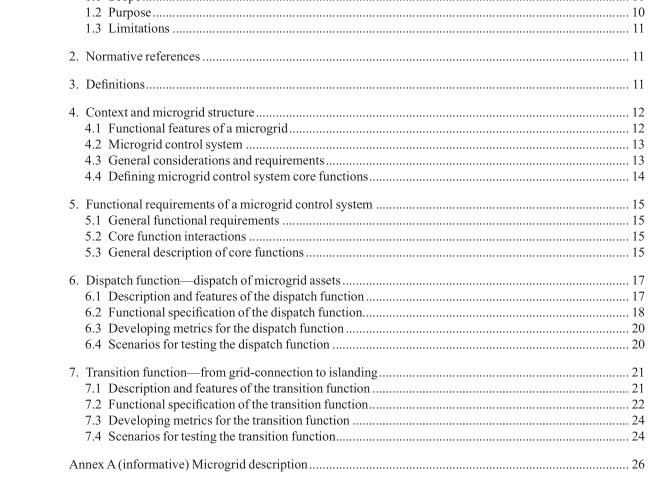IEEE 2030.7-2017 pdf download.IEEE Standard for the Specifcation of Microgrid Controllers
This standard provides technical specifcations and requirements for microgrid controllers. Additionally, there are informative annexes covering the description of the microgrid, the establishment of the functional specifcation, the structure of the microgrid control functions, and a bibliography. These are for informative purposes only, and can be referred to, but they are not required to be used in conjunction with this standard. A key element of microgrid operation is the microgrid energy management system (MEMS). It includes the control functions that defne the microgrid as a system that can manage itself, operate autonomously or grid connected, and seamlessly connect to and disconnect from the main distribution grid for the exchange of power and the supply of ancillary services.
The scope of this standard is to address the technical issues and challenges associated with the proper operation of the MEMS that are common to all microgrids, regardless of topology, confguration, or jurisdiction, and to present the control approaches required from the distribution system operator and the microgrid operator. Testing procedures are addressed. Scenarios and/or use cases for testing are identifed in this standard for dispatch function and transition function respectively. These cases shall be tested according to IEEE P2030.8. 1
1.2 Purpose The reason for establishing a standard for the microgrid energy management system (MEMS) is to enable interoperability of the different controllers and components needed to operate the MEMS through cohesive and platform-independent interfaces. This approach will allow for fexibility and customization of components and control algorithms to be deployed without limiting potential functionality. Microgrid components and operational solutions exist in different confgurations with different implementations. Regardless of whether equipment and software are commercial or custom, components should be interoperable and have interfaces that comply with functional standards defned by the MEMS.
The standardization focuses on defning functions and interface confgurations that allow modularity and interoperability. It deals with the microgrid controller operation, and defnes those aspects that need to be standardized and those that can remain proprietary, while enabling the interoperability with various distributed energy resources (DER) interfaces and facilitating the wide adoption by vendors and utilities. The standard is functionality driven and focuses on a modular approach that enables potential future expansion and features.
1.3 Limitations
The functional requirements in this document are applicable to all ac microgrid controllers, regardless of confguration, and whether they are connected to a distribution network or islanded. Limitations include the following:
— This standard does not defne the individual or aggregate capacity of loads or generation installed in the microgrid. It does not specify voltage levels at the point of connection of the microgrid to the distribution grid nor within the microgrid.
— This standard does not prescribe protection schemes deployed within the microgrid, including protection functions of individual components and assets, nor the protection coordination that may be required with the distribution grid protection schemes.
— This standard does not address planning, designing, and operating the microgrid. This topic is covered in IEEE Std 1547.4™.
—This standard does not address issues related to the power exchanges between the microgrid and the distribution network at the point of interconnection.
— This standard does not address communication systems and the hardware, software, and protocols associated with the implementation of these systems.
— The requirements of this standard apply to a microgrid that has a single point of interconnection with the distribution grid. It does not consider microgrid-to-microgrid use cases or a microgrid that breaks up in sections, with each section operating independently. T
he requirements in this standard are functional and do not specify any particular equipment or equipment type, nor a specifc microgrid hardware or software implementation. It does not address communication systems and the hardware, software, and protocols associated with the implementation of these systems.IEEE 2030.7 pdf download.IEEE 2030.7-2017 pdf download
IEEE 2030.7-2017 pdf download

Leave a Reply